Unit 35: Developing Individuals, Teams, and Organisations Report
VerifiedAdded on 2022/12/23
|15
|4972
|36
Report
AI Summary
This report delves into the critical aspects of developing individuals, teams, and organizations within a business context. It begins by outlining the essential knowledge, skills, and behaviors required of a Human Resources (HR) executive, emphasizing the importance of organizational skills, communication, and employee relations. The report then explores the creation of a personal development plan (PDP) using SWOT analysis to identify areas for improvement, such as communication, team working, and advising skills. Furthermore, the report contrasts organizational and individual growth, highlighting the significance of Continuous Professional Development (CPD) for sustainable business development and the implementation of high-performance work environments. Different approaches to performance management are also discussed. Finally, the report underscores the importance of employee involvement, learning organizations, and the application of Kolb's learning cycle for effective leadership and professional development.
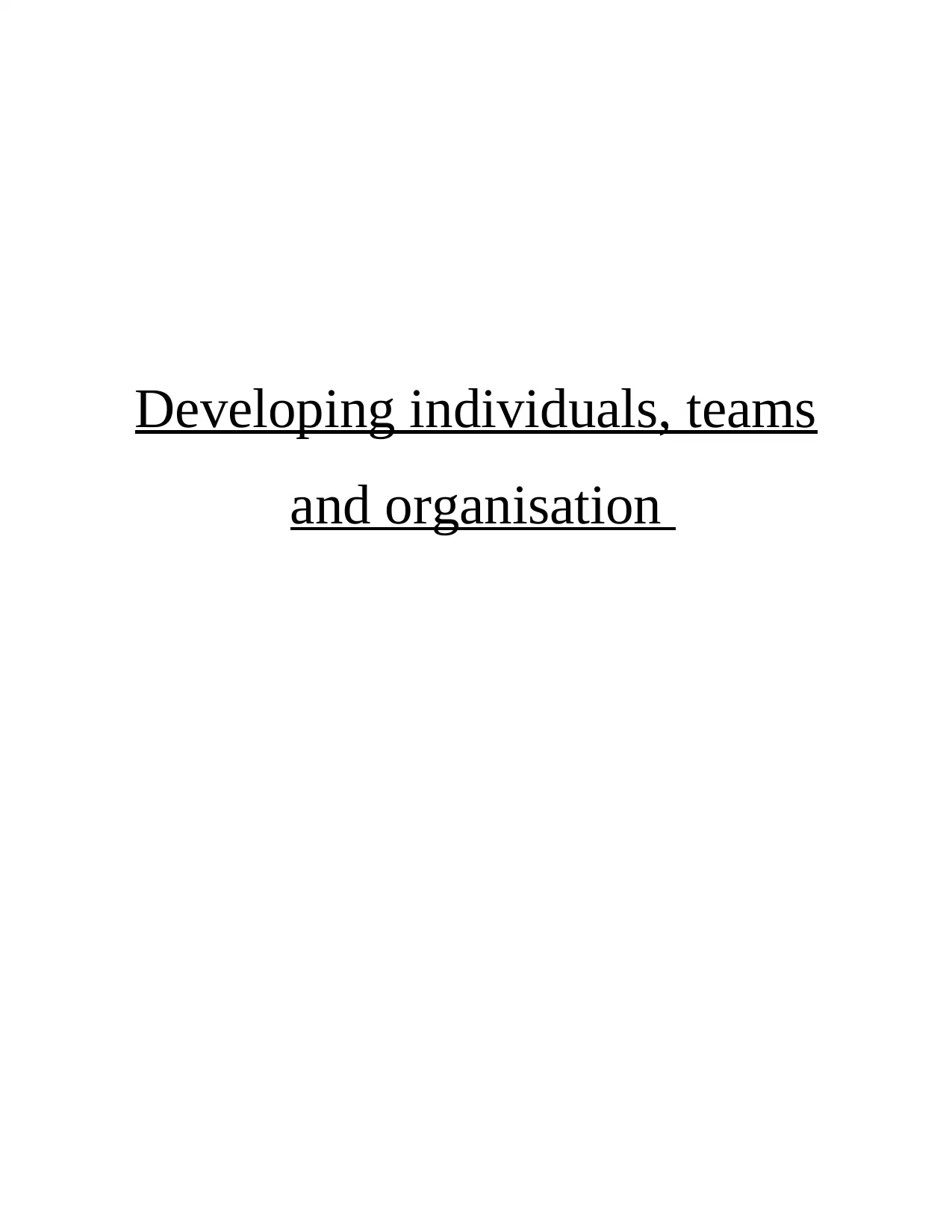
Developing individuals, teams
and organisation
and organisation
Paraphrase This Document
Need a fresh take? Get an instant paraphrase of this document with our AI Paraphraser
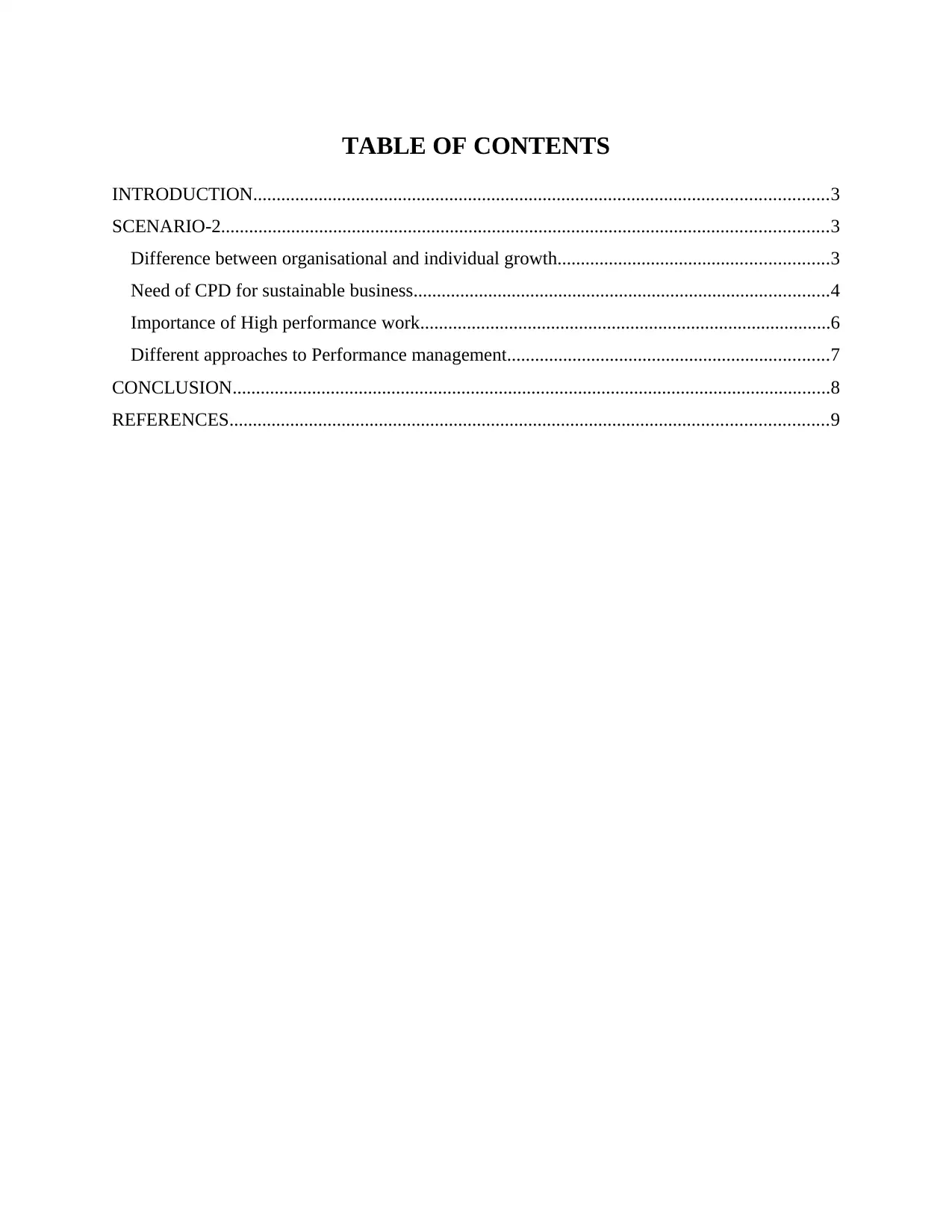
TABLE OF CONTENTS
INTRODUCTION...........................................................................................................................3
SCENARIO-2..................................................................................................................................3
Difference between organisational and individual growth..........................................................3
Need of CPD for sustainable business.........................................................................................4
Importance of High performance work........................................................................................6
Different approaches to Performance management.....................................................................7
CONCLUSION................................................................................................................................8
REFERENCES................................................................................................................................9
INTRODUCTION...........................................................................................................................3
SCENARIO-2..................................................................................................................................3
Difference between organisational and individual growth..........................................................3
Need of CPD for sustainable business.........................................................................................4
Importance of High performance work........................................................................................6
Different approaches to Performance management.....................................................................7
CONCLUSION................................................................................................................................8
REFERENCES................................................................................................................................9
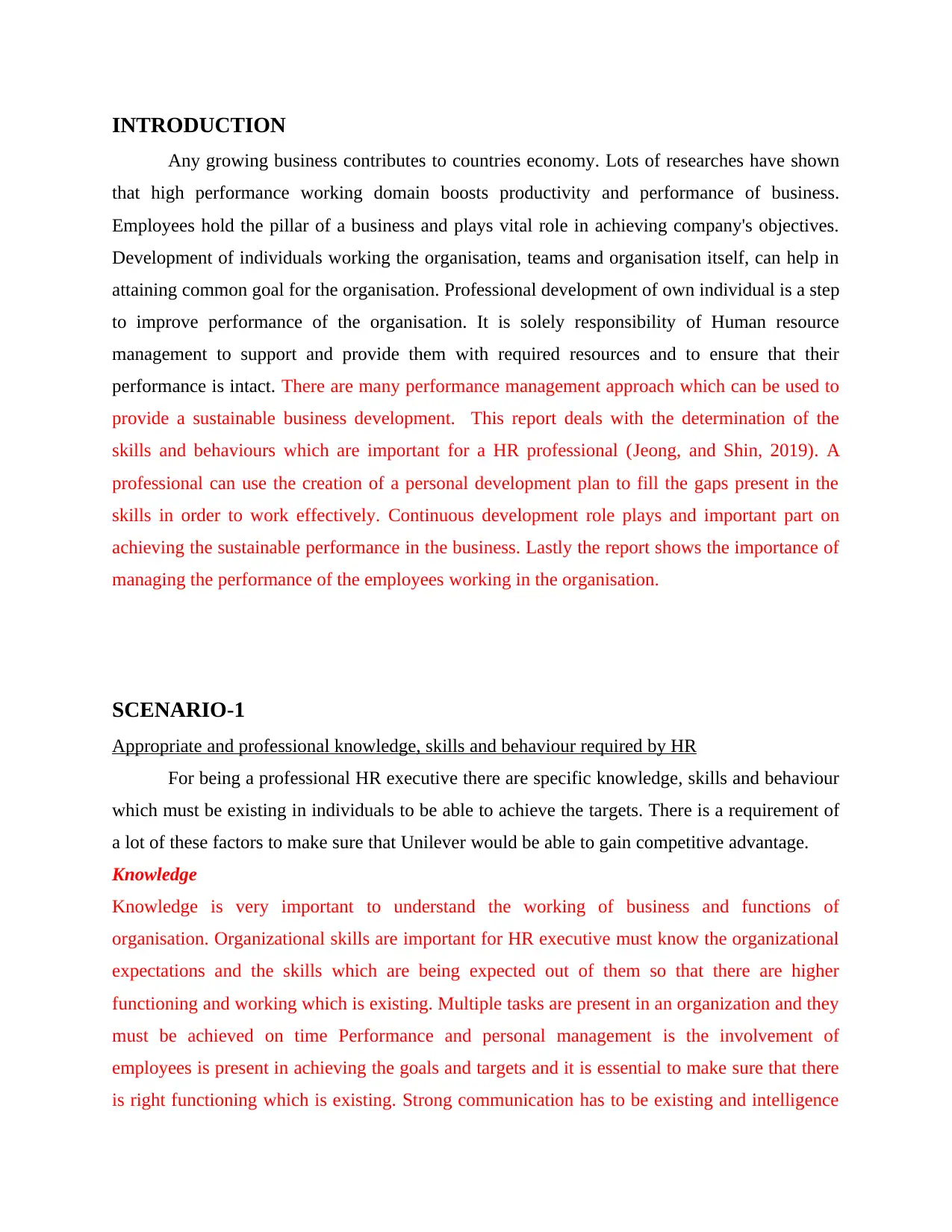
INTRODUCTION
Any growing business contributes to countries economy. Lots of researches have shown
that high performance working domain boosts productivity and performance of business.
Employees hold the pillar of a business and plays vital role in achieving company's objectives.
Development of individuals working the organisation, teams and organisation itself, can help in
attaining common goal for the organisation. Professional development of own individual is a step
to improve performance of the organisation. It is solely responsibility of Human resource
management to support and provide them with required resources and to ensure that their
performance is intact. There are many performance management approach which can be used to
provide a sustainable business development. This report deals with the determination of the
skills and behaviours which are important for a HR professional (Jeong, and Shin, 2019). A
professional can use the creation of a personal development plan to fill the gaps present in the
skills in order to work effectively. Continuous development role plays and important part on
achieving the sustainable performance in the business. Lastly the report shows the importance of
managing the performance of the employees working in the organisation.
SCENARIO-1
Appropriate and professional knowledge, skills and behaviour required by HR
For being a professional HR executive there are specific knowledge, skills and behaviour
which must be existing in individuals to be able to achieve the targets. There is a requirement of
a lot of these factors to make sure that Unilever would be able to gain competitive advantage.
Knowledge
Knowledge is very important to understand the working of business and functions of
organisation. Organizational skills are important for HR executive must know the organizational
expectations and the skills which are being expected out of them so that there are higher
functioning and working which is existing. Multiple tasks are present in an organization and they
must be achieved on time Performance and personal management is the involvement of
employees is present in achieving the goals and targets and it is essential to make sure that there
is right functioning which is existing. Strong communication has to be existing and intelligence
Any growing business contributes to countries economy. Lots of researches have shown
that high performance working domain boosts productivity and performance of business.
Employees hold the pillar of a business and plays vital role in achieving company's objectives.
Development of individuals working the organisation, teams and organisation itself, can help in
attaining common goal for the organisation. Professional development of own individual is a step
to improve performance of the organisation. It is solely responsibility of Human resource
management to support and provide them with required resources and to ensure that their
performance is intact. There are many performance management approach which can be used to
provide a sustainable business development. This report deals with the determination of the
skills and behaviours which are important for a HR professional (Jeong, and Shin, 2019). A
professional can use the creation of a personal development plan to fill the gaps present in the
skills in order to work effectively. Continuous development role plays and important part on
achieving the sustainable performance in the business. Lastly the report shows the importance of
managing the performance of the employees working in the organisation.
SCENARIO-1
Appropriate and professional knowledge, skills and behaviour required by HR
For being a professional HR executive there are specific knowledge, skills and behaviour
which must be existing in individuals to be able to achieve the targets. There is a requirement of
a lot of these factors to make sure that Unilever would be able to gain competitive advantage.
Knowledge
Knowledge is very important to understand the working of business and functions of
organisation. Organizational skills are important for HR executive must know the organizational
expectations and the skills which are being expected out of them so that there are higher
functioning and working which is existing. Multiple tasks are present in an organization and they
must be achieved on time Performance and personal management is the involvement of
employees is present in achieving the goals and targets and it is essential to make sure that there
is right functioning which is existing. Strong communication has to be existing and intelligence
⊘ This is a preview!⊘
Do you want full access?
Subscribe today to unlock all pages.

Trusted by 1+ million students worldwide
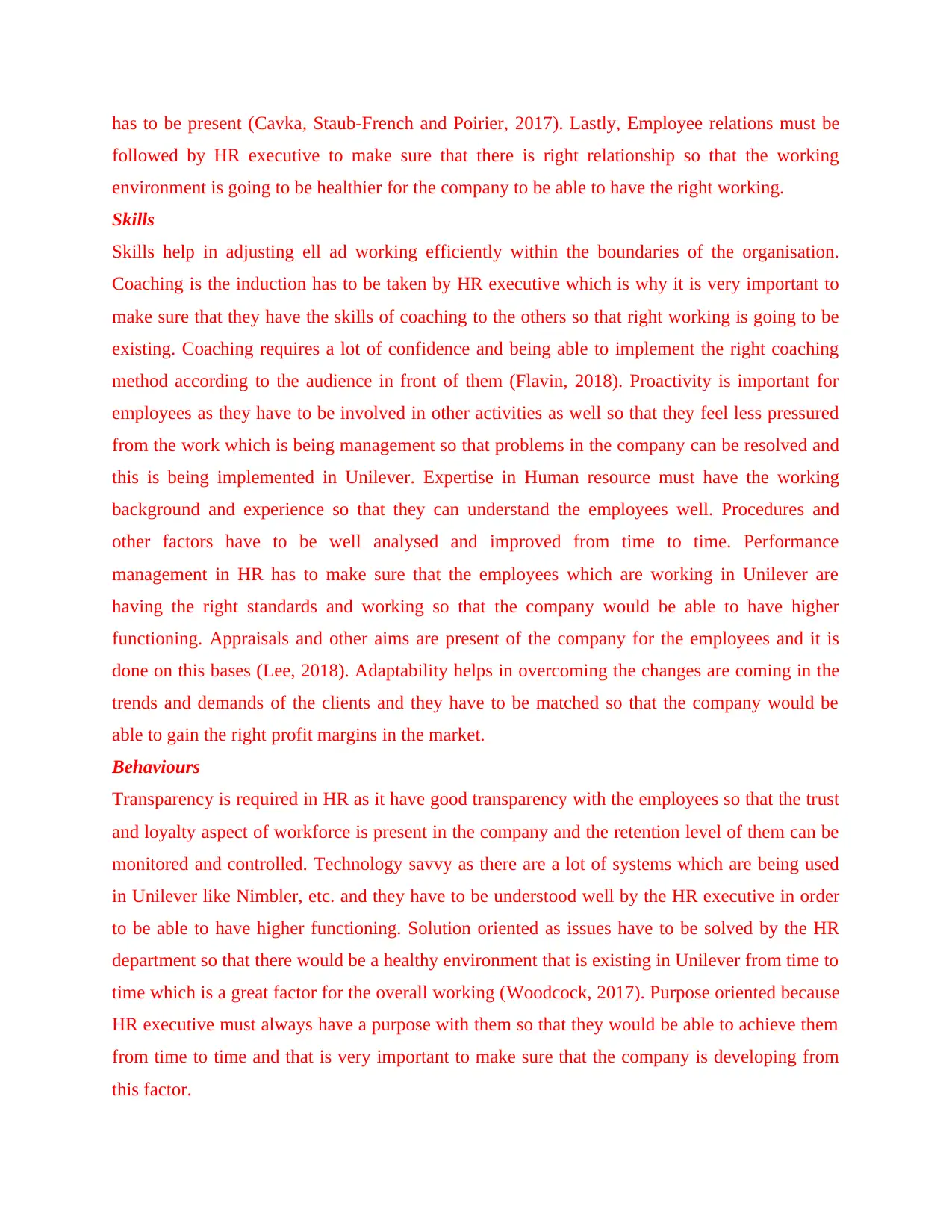
has to be present (Cavka, Staub-French and Poirier, 2017). Lastly, Employee relations must be
followed by HR executive to make sure that there is right relationship so that the working
environment is going to be healthier for the company to be able to have the right working.
Skills
Skills help in adjusting ell ad working efficiently within the boundaries of the organisation.
Coaching is the induction has to be taken by HR executive which is why it is very important to
make sure that they have the skills of coaching to the others so that right working is going to be
existing. Coaching requires a lot of confidence and being able to implement the right coaching
method according to the audience in front of them (Flavin, 2018). Proactivity is important for
employees as they have to be involved in other activities as well so that they feel less pressured
from the work which is being management so that problems in the company can be resolved and
this is being implemented in Unilever. Expertise in Human resource must have the working
background and experience so that they can understand the employees well. Procedures and
other factors have to be well analysed and improved from time to time. Performance
management in HR has to make sure that the employees which are working in Unilever are
having the right standards and working so that the company would be able to have higher
functioning. Appraisals and other aims are present of the company for the employees and it is
done on this bases (Lee, 2018). Adaptability helps in overcoming the changes are coming in the
trends and demands of the clients and they have to be matched so that the company would be
able to gain the right profit margins in the market.
Behaviours
Transparency is required in HR as it have good transparency with the employees so that the trust
and loyalty aspect of workforce is present in the company and the retention level of them can be
monitored and controlled. Technology savvy as there are a lot of systems which are being used
in Unilever like Nimbler, etc. and they have to be understood well by the HR executive in order
to be able to have higher functioning. Solution oriented as issues have to be solved by the HR
department so that there would be a healthy environment that is existing in Unilever from time to
time which is a great factor for the overall working (Woodcock, 2017). Purpose oriented because
HR executive must always have a purpose with them so that they would be able to achieve them
from time to time and that is very important to make sure that the company is developing from
this factor.
followed by HR executive to make sure that there is right relationship so that the working
environment is going to be healthier for the company to be able to have the right working.
Skills
Skills help in adjusting ell ad working efficiently within the boundaries of the organisation.
Coaching is the induction has to be taken by HR executive which is why it is very important to
make sure that they have the skills of coaching to the others so that right working is going to be
existing. Coaching requires a lot of confidence and being able to implement the right coaching
method according to the audience in front of them (Flavin, 2018). Proactivity is important for
employees as they have to be involved in other activities as well so that they feel less pressured
from the work which is being management so that problems in the company can be resolved and
this is being implemented in Unilever. Expertise in Human resource must have the working
background and experience so that they can understand the employees well. Procedures and
other factors have to be well analysed and improved from time to time. Performance
management in HR has to make sure that the employees which are working in Unilever are
having the right standards and working so that the company would be able to have higher
functioning. Appraisals and other aims are present of the company for the employees and it is
done on this bases (Lee, 2018). Adaptability helps in overcoming the changes are coming in the
trends and demands of the clients and they have to be matched so that the company would be
able to gain the right profit margins in the market.
Behaviours
Transparency is required in HR as it have good transparency with the employees so that the trust
and loyalty aspect of workforce is present in the company and the retention level of them can be
monitored and controlled. Technology savvy as there are a lot of systems which are being used
in Unilever like Nimbler, etc. and they have to be understood well by the HR executive in order
to be able to have higher functioning. Solution oriented as issues have to be solved by the HR
department so that there would be a healthy environment that is existing in Unilever from time to
time which is a great factor for the overall working (Woodcock, 2017). Purpose oriented because
HR executive must always have a purpose with them so that they would be able to achieve them
from time to time and that is very important to make sure that the company is developing from
this factor.
Paraphrase This Document
Need a fresh take? Get an instant paraphrase of this document with our AI Paraphraser
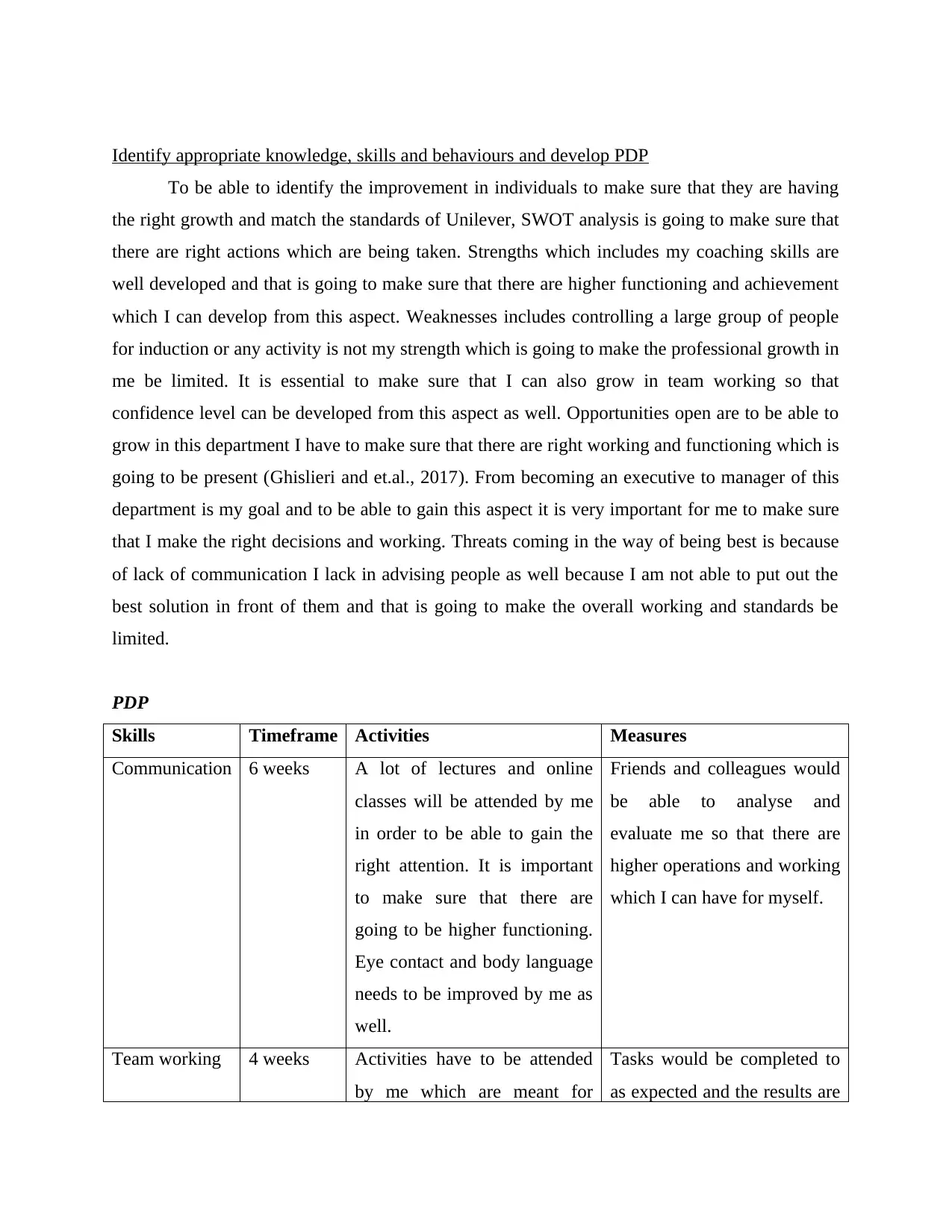
Identify appropriate knowledge, skills and behaviours and develop PDP
To be able to identify the improvement in individuals to make sure that they are having
the right growth and match the standards of Unilever, SWOT analysis is going to make sure that
there are right actions which are being taken. Strengths which includes my coaching skills are
well developed and that is going to make sure that there are higher functioning and achievement
which I can develop from this aspect. Weaknesses includes controlling a large group of people
for induction or any activity is not my strength which is going to make the professional growth in
me be limited. It is essential to make sure that I can also grow in team working so that
confidence level can be developed from this aspect as well. Opportunities open are to be able to
grow in this department I have to make sure that there are right working and functioning which is
going to be present (Ghislieri and et.al., 2017). From becoming an executive to manager of this
department is my goal and to be able to gain this aspect it is very important for me to make sure
that I make the right decisions and working. Threats coming in the way of being best is because
of lack of communication I lack in advising people as well because I am not able to put out the
best solution in front of them and that is going to make the overall working and standards be
limited.
PDP
Skills Timeframe Activities Measures
Communication 6 weeks A lot of lectures and online
classes will be attended by me
in order to be able to gain the
right attention. It is important
to make sure that there are
going to be higher functioning.
Eye contact and body language
needs to be improved by me as
well.
Friends and colleagues would
be able to analyse and
evaluate me so that there are
higher operations and working
which I can have for myself.
Team working 4 weeks Activities have to be attended
by me which are meant for
Tasks would be completed to
as expected and the results are
To be able to identify the improvement in individuals to make sure that they are having
the right growth and match the standards of Unilever, SWOT analysis is going to make sure that
there are right actions which are being taken. Strengths which includes my coaching skills are
well developed and that is going to make sure that there are higher functioning and achievement
which I can develop from this aspect. Weaknesses includes controlling a large group of people
for induction or any activity is not my strength which is going to make the professional growth in
me be limited. It is essential to make sure that I can also grow in team working so that
confidence level can be developed from this aspect as well. Opportunities open are to be able to
grow in this department I have to make sure that there are right working and functioning which is
going to be present (Ghislieri and et.al., 2017). From becoming an executive to manager of this
department is my goal and to be able to gain this aspect it is very important for me to make sure
that I make the right decisions and working. Threats coming in the way of being best is because
of lack of communication I lack in advising people as well because I am not able to put out the
best solution in front of them and that is going to make the overall working and standards be
limited.
PDP
Skills Timeframe Activities Measures
Communication 6 weeks A lot of lectures and online
classes will be attended by me
in order to be able to gain the
right attention. It is important
to make sure that there are
going to be higher functioning.
Eye contact and body language
needs to be improved by me as
well.
Friends and colleagues would
be able to analyse and
evaluate me so that there are
higher operations and working
which I can have for myself.
Team working 4 weeks Activities have to be attended
by me which are meant for
Tasks would be completed to
as expected and the results are
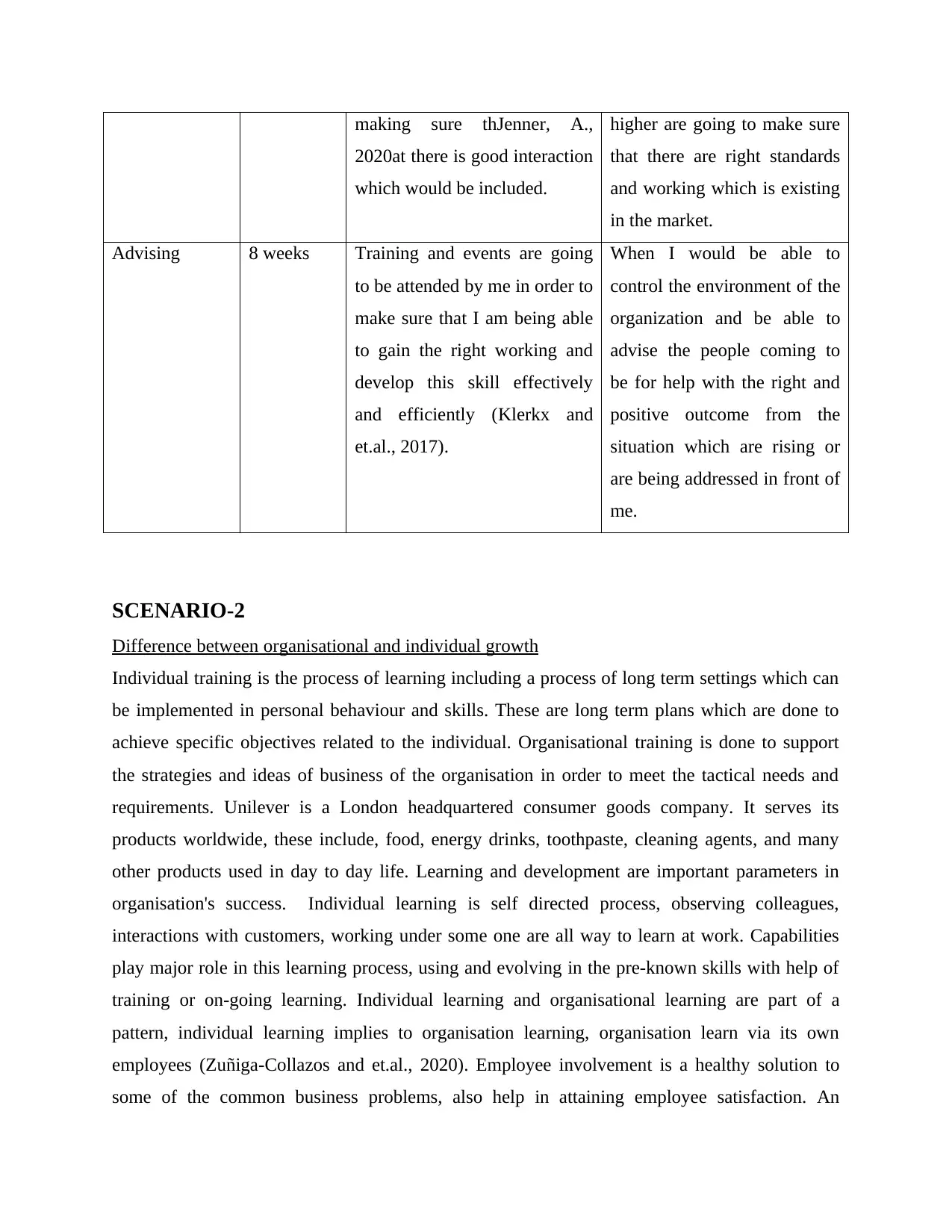
making sure thJenner, A.,
2020at there is good interaction
which would be included.
higher are going to make sure
that there are right standards
and working which is existing
in the market.
Advising 8 weeks Training and events are going
to be attended by me in order to
make sure that I am being able
to gain the right working and
develop this skill effectively
and efficiently (Klerkx and
et.al., 2017).
When I would be able to
control the environment of the
organization and be able to
advise the people coming to
be for help with the right and
positive outcome from the
situation which are rising or
are being addressed in front of
me.
SCENARIO-2
Difference between organisational and individual growth
Individual training is the process of learning including a process of long term settings which can
be implemented in personal behaviour and skills. These are long term plans which are done to
achieve specific objectives related to the individual. Organisational training is done to support
the strategies and ideas of business of the organisation in order to meet the tactical needs and
requirements. Unilever is a London headquartered consumer goods company. It serves its
products worldwide, these include, food, energy drinks, toothpaste, cleaning agents, and many
other products used in day to day life. Learning and development are important parameters in
organisation's success. Individual learning is self directed process, observing colleagues,
interactions with customers, working under some one are all way to learn at work. Capabilities
play major role in this learning process, using and evolving in the pre-known skills with help of
training or on-going learning. Individual learning and organisational learning are part of a
pattern, individual learning implies to organisation learning, organisation learn via its own
employees (Zuñiga-Collazos and et.al., 2020). Employee involvement is a healthy solution to
some of the common business problems, also help in attaining employee satisfaction. An
2020at there is good interaction
which would be included.
higher are going to make sure
that there are right standards
and working which is existing
in the market.
Advising 8 weeks Training and events are going
to be attended by me in order to
make sure that I am being able
to gain the right working and
develop this skill effectively
and efficiently (Klerkx and
et.al., 2017).
When I would be able to
control the environment of the
organization and be able to
advise the people coming to
be for help with the right and
positive outcome from the
situation which are rising or
are being addressed in front of
me.
SCENARIO-2
Difference between organisational and individual growth
Individual training is the process of learning including a process of long term settings which can
be implemented in personal behaviour and skills. These are long term plans which are done to
achieve specific objectives related to the individual. Organisational training is done to support
the strategies and ideas of business of the organisation in order to meet the tactical needs and
requirements. Unilever is a London headquartered consumer goods company. It serves its
products worldwide, these include, food, energy drinks, toothpaste, cleaning agents, and many
other products used in day to day life. Learning and development are important parameters in
organisation's success. Individual learning is self directed process, observing colleagues,
interactions with customers, working under some one are all way to learn at work. Capabilities
play major role in this learning process, using and evolving in the pre-known skills with help of
training or on-going learning. Individual learning and organisational learning are part of a
pattern, individual learning implies to organisation learning, organisation learn via its own
employees (Zuñiga-Collazos and et.al., 2020). Employee involvement is a healthy solution to
some of the common business problems, also help in attaining employee satisfaction. An
⊘ This is a preview!⊘
Do you want full access?
Subscribe today to unlock all pages.

Trusted by 1+ million students worldwide
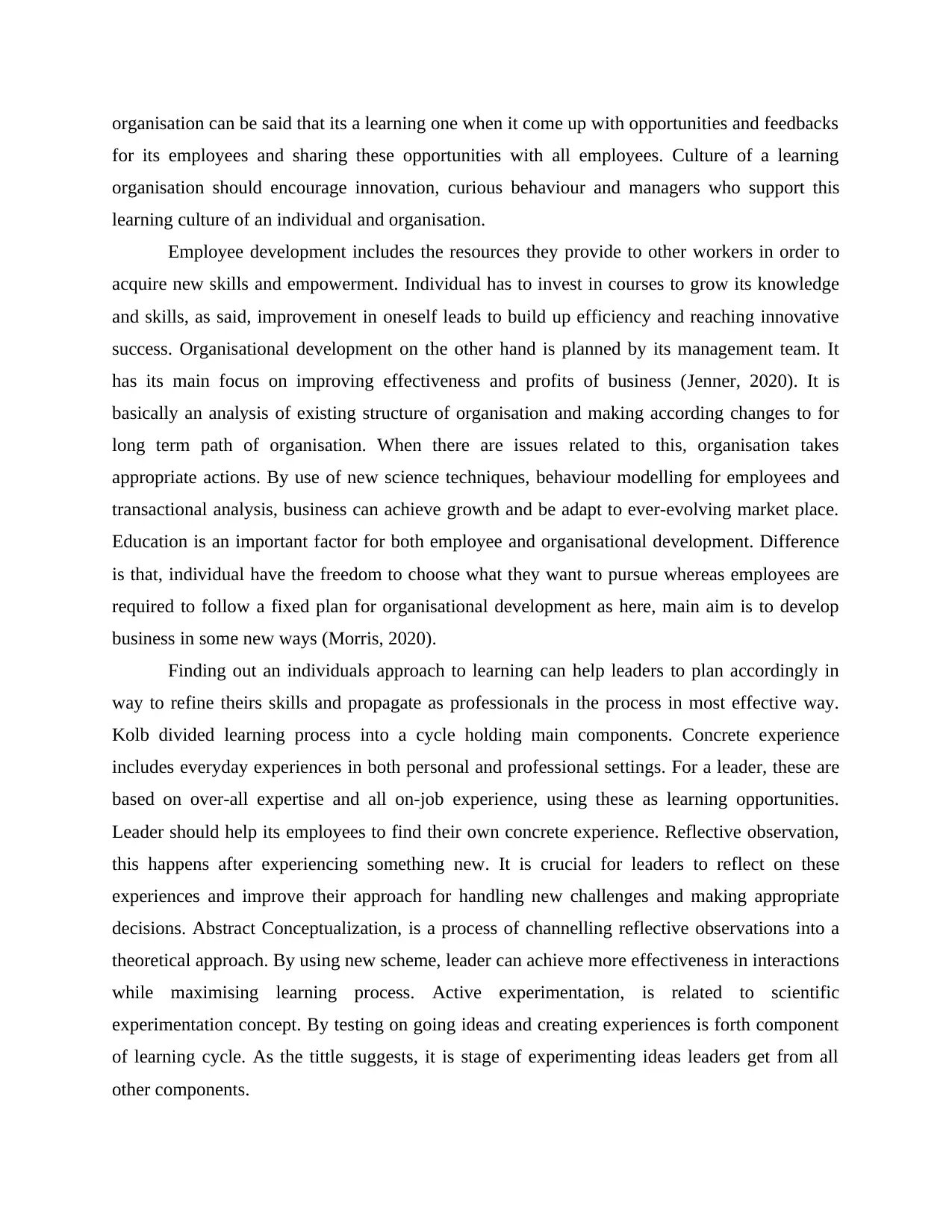
organisation can be said that its a learning one when it come up with opportunities and feedbacks
for its employees and sharing these opportunities with all employees. Culture of a learning
organisation should encourage innovation, curious behaviour and managers who support this
learning culture of an individual and organisation.
Employee development includes the resources they provide to other workers in order to
acquire new skills and empowerment. Individual has to invest in courses to grow its knowledge
and skills, as said, improvement in oneself leads to build up efficiency and reaching innovative
success. Organisational development on the other hand is planned by its management team. It
has its main focus on improving effectiveness and profits of business (Jenner, 2020). It is
basically an analysis of existing structure of organisation and making according changes to for
long term path of organisation. When there are issues related to this, organisation takes
appropriate actions. By use of new science techniques, behaviour modelling for employees and
transactional analysis, business can achieve growth and be adapt to ever-evolving market place.
Education is an important factor for both employee and organisational development. Difference
is that, individual have the freedom to choose what they want to pursue whereas employees are
required to follow a fixed plan for organisational development as here, main aim is to develop
business in some new ways (Morris, 2020).
Finding out an individuals approach to learning can help leaders to plan accordingly in
way to refine theirs skills and propagate as professionals in the process in most effective way.
Kolb divided learning process into a cycle holding main components. Concrete experience
includes everyday experiences in both personal and professional settings. For a leader, these are
based on over-all expertise and all on-job experience, using these as learning opportunities.
Leader should help its employees to find their own concrete experience. Reflective observation,
this happens after experiencing something new. It is crucial for leaders to reflect on these
experiences and improve their approach for handling new challenges and making appropriate
decisions. Abstract Conceptualization, is a process of channelling reflective observations into a
theoretical approach. By using new scheme, leader can achieve more effectiveness in interactions
while maximising learning process. Active experimentation, is related to scientific
experimentation concept. By testing on going ideas and creating experiences is forth component
of learning cycle. As the tittle suggests, it is stage of experimenting ideas leaders get from all
other components.
for its employees and sharing these opportunities with all employees. Culture of a learning
organisation should encourage innovation, curious behaviour and managers who support this
learning culture of an individual and organisation.
Employee development includes the resources they provide to other workers in order to
acquire new skills and empowerment. Individual has to invest in courses to grow its knowledge
and skills, as said, improvement in oneself leads to build up efficiency and reaching innovative
success. Organisational development on the other hand is planned by its management team. It
has its main focus on improving effectiveness and profits of business (Jenner, 2020). It is
basically an analysis of existing structure of organisation and making according changes to for
long term path of organisation. When there are issues related to this, organisation takes
appropriate actions. By use of new science techniques, behaviour modelling for employees and
transactional analysis, business can achieve growth and be adapt to ever-evolving market place.
Education is an important factor for both employee and organisational development. Difference
is that, individual have the freedom to choose what they want to pursue whereas employees are
required to follow a fixed plan for organisational development as here, main aim is to develop
business in some new ways (Morris, 2020).
Finding out an individuals approach to learning can help leaders to plan accordingly in
way to refine theirs skills and propagate as professionals in the process in most effective way.
Kolb divided learning process into a cycle holding main components. Concrete experience
includes everyday experiences in both personal and professional settings. For a leader, these are
based on over-all expertise and all on-job experience, using these as learning opportunities.
Leader should help its employees to find their own concrete experience. Reflective observation,
this happens after experiencing something new. It is crucial for leaders to reflect on these
experiences and improve their approach for handling new challenges and making appropriate
decisions. Abstract Conceptualization, is a process of channelling reflective observations into a
theoretical approach. By using new scheme, leader can achieve more effectiveness in interactions
while maximising learning process. Active experimentation, is related to scientific
experimentation concept. By testing on going ideas and creating experiences is forth component
of learning cycle. As the tittle suggests, it is stage of experimenting ideas leaders get from all
other components.
Paraphrase This Document
Need a fresh take? Get an instant paraphrase of this document with our AI Paraphraser
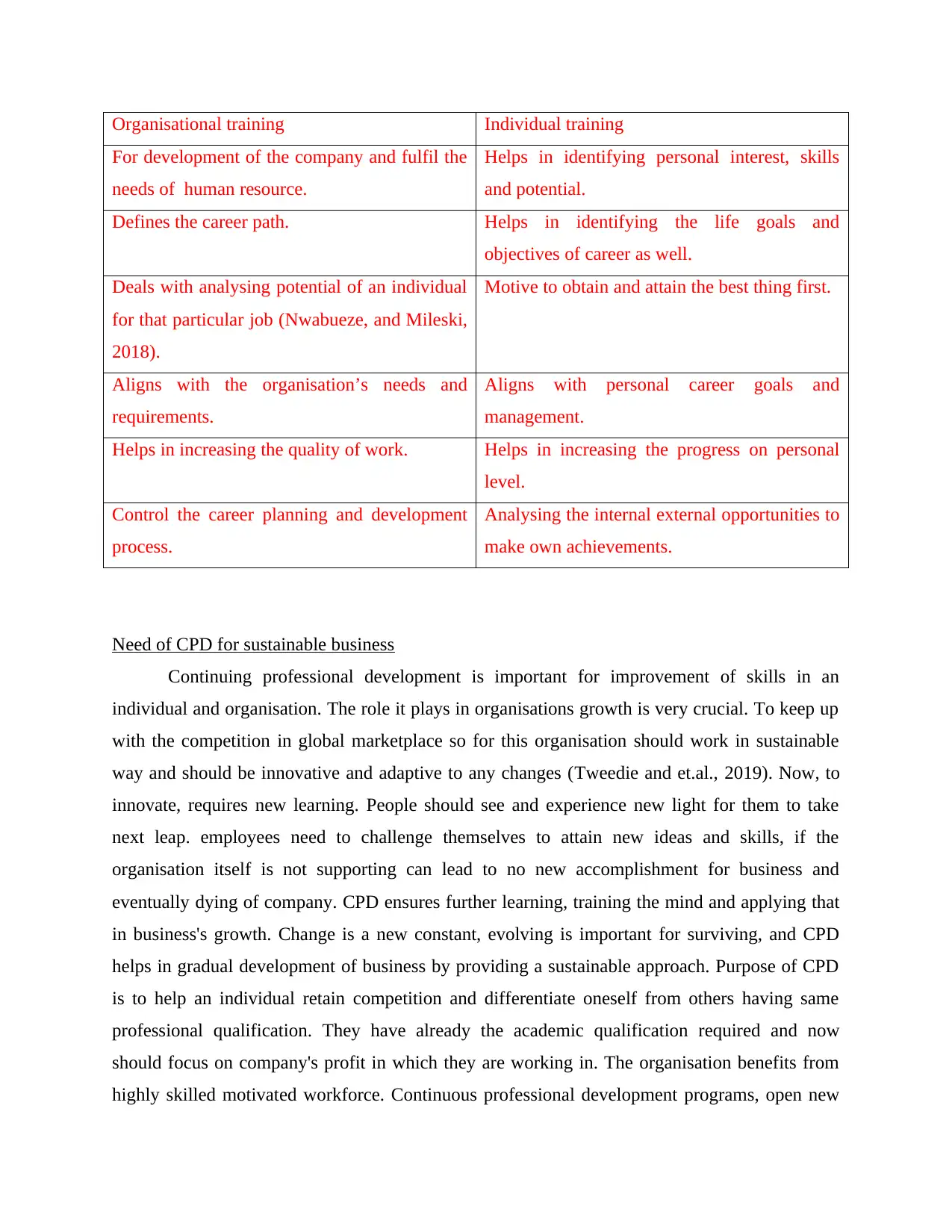
Organisational training Individual training
For development of the company and fulfil the
needs of human resource.
Helps in identifying personal interest, skills
and potential.
Defines the career path. Helps in identifying the life goals and
objectives of career as well.
Deals with analysing potential of an individual
for that particular job (Nwabueze, and Mileski,
2018).
Motive to obtain and attain the best thing first.
Aligns with the organisation’s needs and
requirements.
Aligns with personal career goals and
management.
Helps in increasing the quality of work. Helps in increasing the progress on personal
level.
Control the career planning and development
process.
Analysing the internal external opportunities to
make own achievements.
Need of CPD for sustainable business
Continuing professional development is important for improvement of skills in an
individual and organisation. The role it plays in organisations growth is very crucial. To keep up
with the competition in global marketplace so for this organisation should work in sustainable
way and should be innovative and adaptive to any changes (Tweedie and et.al., 2019). Now, to
innovate, requires new learning. People should see and experience new light for them to take
next leap. employees need to challenge themselves to attain new ideas and skills, if the
organisation itself is not supporting can lead to no new accomplishment for business and
eventually dying of company. CPD ensures further learning, training the mind and applying that
in business's growth. Change is a new constant, evolving is important for surviving, and CPD
helps in gradual development of business by providing a sustainable approach. Purpose of CPD
is to help an individual retain competition and differentiate oneself from others having same
professional qualification. They have already the academic qualification required and now
should focus on company's profit in which they are working in. The organisation benefits from
highly skilled motivated workforce. Continuous professional development programs, open new
For development of the company and fulfil the
needs of human resource.
Helps in identifying personal interest, skills
and potential.
Defines the career path. Helps in identifying the life goals and
objectives of career as well.
Deals with analysing potential of an individual
for that particular job (Nwabueze, and Mileski,
2018).
Motive to obtain and attain the best thing first.
Aligns with the organisation’s needs and
requirements.
Aligns with personal career goals and
management.
Helps in increasing the quality of work. Helps in increasing the progress on personal
level.
Control the career planning and development
process.
Analysing the internal external opportunities to
make own achievements.
Need of CPD for sustainable business
Continuing professional development is important for improvement of skills in an
individual and organisation. The role it plays in organisations growth is very crucial. To keep up
with the competition in global marketplace so for this organisation should work in sustainable
way and should be innovative and adaptive to any changes (Tweedie and et.al., 2019). Now, to
innovate, requires new learning. People should see and experience new light for them to take
next leap. employees need to challenge themselves to attain new ideas and skills, if the
organisation itself is not supporting can lead to no new accomplishment for business and
eventually dying of company. CPD ensures further learning, training the mind and applying that
in business's growth. Change is a new constant, evolving is important for surviving, and CPD
helps in gradual development of business by providing a sustainable approach. Purpose of CPD
is to help an individual retain competition and differentiate oneself from others having same
professional qualification. They have already the academic qualification required and now
should focus on company's profit in which they are working in. The organisation benefits from
highly skilled motivated workforce. Continuous professional development programs, open new
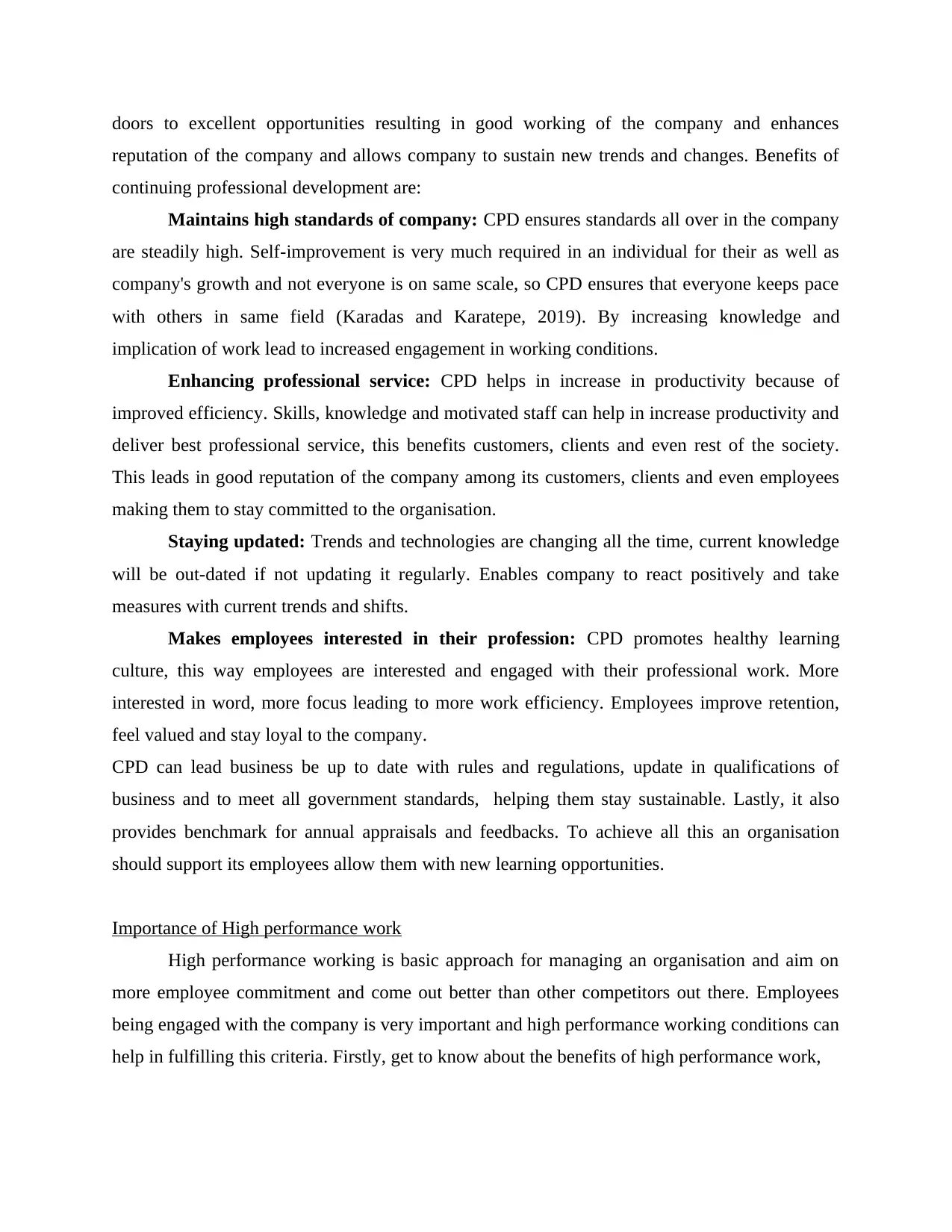
doors to excellent opportunities resulting in good working of the company and enhances
reputation of the company and allows company to sustain new trends and changes. Benefits of
continuing professional development are:
Maintains high standards of company: CPD ensures standards all over in the company
are steadily high. Self-improvement is very much required in an individual for their as well as
company's growth and not everyone is on same scale, so CPD ensures that everyone keeps pace
with others in same field (Karadas and Karatepe, 2019). By increasing knowledge and
implication of work lead to increased engagement in working conditions.
Enhancing professional service: CPD helps in increase in productivity because of
improved efficiency. Skills, knowledge and motivated staff can help in increase productivity and
deliver best professional service, this benefits customers, clients and even rest of the society.
This leads in good reputation of the company among its customers, clients and even employees
making them to stay committed to the organisation.
Staying updated: Trends and technologies are changing all the time, current knowledge
will be out-dated if not updating it regularly. Enables company to react positively and take
measures with current trends and shifts.
Makes employees interested in their profession: CPD promotes healthy learning
culture, this way employees are interested and engaged with their professional work. More
interested in word, more focus leading to more work efficiency. Employees improve retention,
feel valued and stay loyal to the company.
CPD can lead business be up to date with rules and regulations, update in qualifications of
business and to meet all government standards, helping them stay sustainable. Lastly, it also
provides benchmark for annual appraisals and feedbacks. To achieve all this an organisation
should support its employees allow them with new learning opportunities.
Importance of High performance work
High performance working is basic approach for managing an organisation and aim on
more employee commitment and come out better than other competitors out there. Employees
being engaged with the company is very important and high performance working conditions can
help in fulfilling this criteria. Firstly, get to know about the benefits of high performance work,
reputation of the company and allows company to sustain new trends and changes. Benefits of
continuing professional development are:
Maintains high standards of company: CPD ensures standards all over in the company
are steadily high. Self-improvement is very much required in an individual for their as well as
company's growth and not everyone is on same scale, so CPD ensures that everyone keeps pace
with others in same field (Karadas and Karatepe, 2019). By increasing knowledge and
implication of work lead to increased engagement in working conditions.
Enhancing professional service: CPD helps in increase in productivity because of
improved efficiency. Skills, knowledge and motivated staff can help in increase productivity and
deliver best professional service, this benefits customers, clients and even rest of the society.
This leads in good reputation of the company among its customers, clients and even employees
making them to stay committed to the organisation.
Staying updated: Trends and technologies are changing all the time, current knowledge
will be out-dated if not updating it regularly. Enables company to react positively and take
measures with current trends and shifts.
Makes employees interested in their profession: CPD promotes healthy learning
culture, this way employees are interested and engaged with their professional work. More
interested in word, more focus leading to more work efficiency. Employees improve retention,
feel valued and stay loyal to the company.
CPD can lead business be up to date with rules and regulations, update in qualifications of
business and to meet all government standards, helping them stay sustainable. Lastly, it also
provides benchmark for annual appraisals and feedbacks. To achieve all this an organisation
should support its employees allow them with new learning opportunities.
Importance of High performance work
High performance working is basic approach for managing an organisation and aim on
more employee commitment and come out better than other competitors out there. Employees
being engaged with the company is very important and high performance working conditions can
help in fulfilling this criteria. Firstly, get to know about the benefits of high performance work,
⊘ This is a preview!⊘
Do you want full access?
Subscribe today to unlock all pages.

Trusted by 1+ million students worldwide
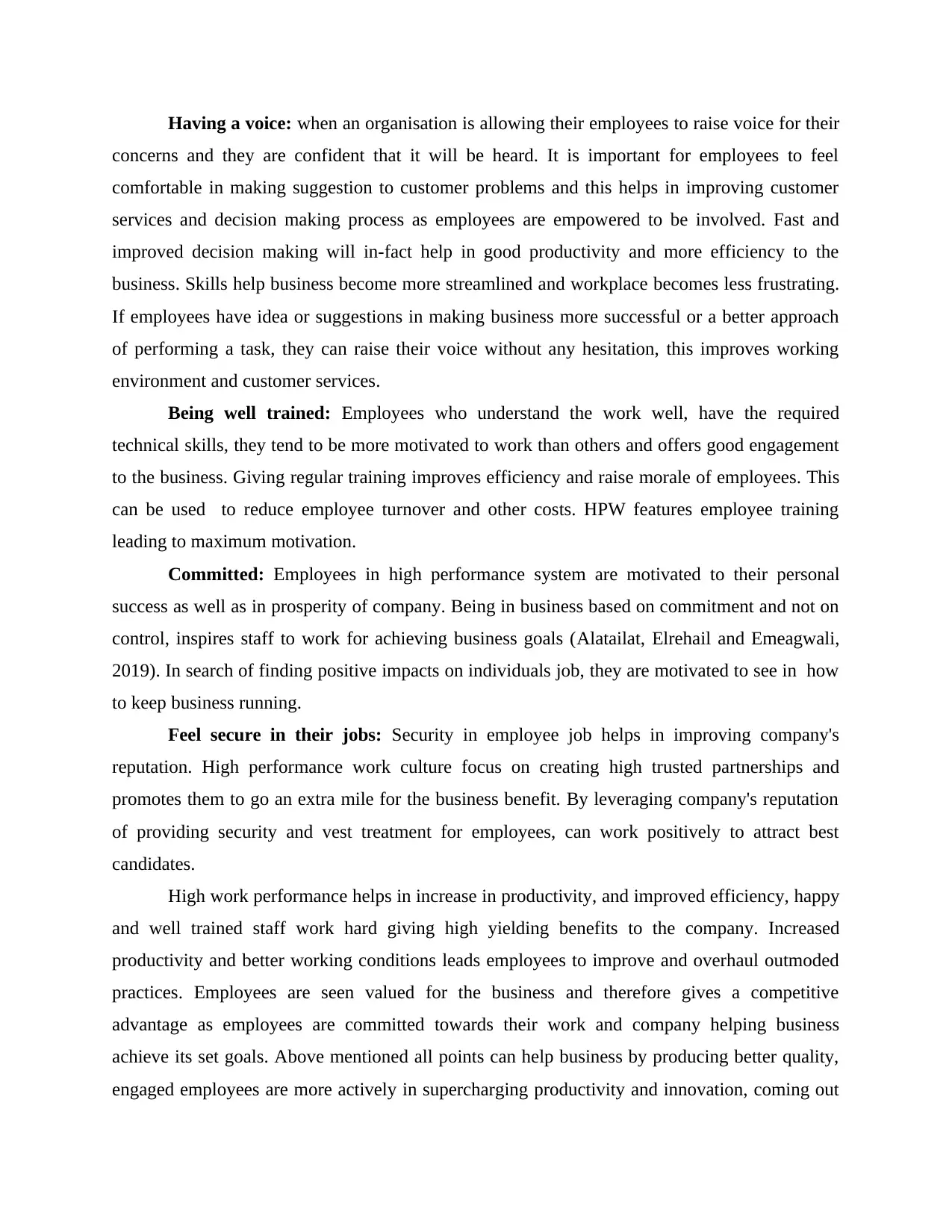
Having a voice: when an organisation is allowing their employees to raise voice for their
concerns and they are confident that it will be heard. It is important for employees to feel
comfortable in making suggestion to customer problems and this helps in improving customer
services and decision making process as employees are empowered to be involved. Fast and
improved decision making will in-fact help in good productivity and more efficiency to the
business. Skills help business become more streamlined and workplace becomes less frustrating.
If employees have idea or suggestions in making business more successful or a better approach
of performing a task, they can raise their voice without any hesitation, this improves working
environment and customer services.
Being well trained: Employees who understand the work well, have the required
technical skills, they tend to be more motivated to work than others and offers good engagement
to the business. Giving regular training improves efficiency and raise morale of employees. This
can be used to reduce employee turnover and other costs. HPW features employee training
leading to maximum motivation.
Committed: Employees in high performance system are motivated to their personal
success as well as in prosperity of company. Being in business based on commitment and not on
control, inspires staff to work for achieving business goals (Alatailat, Elrehail and Emeagwali,
2019). In search of finding positive impacts on individuals job, they are motivated to see in how
to keep business running.
Feel secure in their jobs: Security in employee job helps in improving company's
reputation. High performance work culture focus on creating high trusted partnerships and
promotes them to go an extra mile for the business benefit. By leveraging company's reputation
of providing security and vest treatment for employees, can work positively to attract best
candidates.
High work performance helps in increase in productivity, and improved efficiency, happy
and well trained staff work hard giving high yielding benefits to the company. Increased
productivity and better working conditions leads employees to improve and overhaul outmoded
practices. Employees are seen valued for the business and therefore gives a competitive
advantage as employees are committed towards their work and company helping business
achieve its set goals. Above mentioned all points can help business by producing better quality,
engaged employees are more actively in supercharging productivity and innovation, coming out
concerns and they are confident that it will be heard. It is important for employees to feel
comfortable in making suggestion to customer problems and this helps in improving customer
services and decision making process as employees are empowered to be involved. Fast and
improved decision making will in-fact help in good productivity and more efficiency to the
business. Skills help business become more streamlined and workplace becomes less frustrating.
If employees have idea or suggestions in making business more successful or a better approach
of performing a task, they can raise their voice without any hesitation, this improves working
environment and customer services.
Being well trained: Employees who understand the work well, have the required
technical skills, they tend to be more motivated to work than others and offers good engagement
to the business. Giving regular training improves efficiency and raise morale of employees. This
can be used to reduce employee turnover and other costs. HPW features employee training
leading to maximum motivation.
Committed: Employees in high performance system are motivated to their personal
success as well as in prosperity of company. Being in business based on commitment and not on
control, inspires staff to work for achieving business goals (Alatailat, Elrehail and Emeagwali,
2019). In search of finding positive impacts on individuals job, they are motivated to see in how
to keep business running.
Feel secure in their jobs: Security in employee job helps in improving company's
reputation. High performance work culture focus on creating high trusted partnerships and
promotes them to go an extra mile for the business benefit. By leveraging company's reputation
of providing security and vest treatment for employees, can work positively to attract best
candidates.
High work performance helps in increase in productivity, and improved efficiency, happy
and well trained staff work hard giving high yielding benefits to the company. Increased
productivity and better working conditions leads employees to improve and overhaul outmoded
practices. Employees are seen valued for the business and therefore gives a competitive
advantage as employees are committed towards their work and company helping business
achieve its set goals. Above mentioned all points can help business by producing better quality,
engaged employees are more actively in supercharging productivity and innovation, coming out
Paraphrase This Document
Need a fresh take? Get an instant paraphrase of this document with our AI Paraphraser
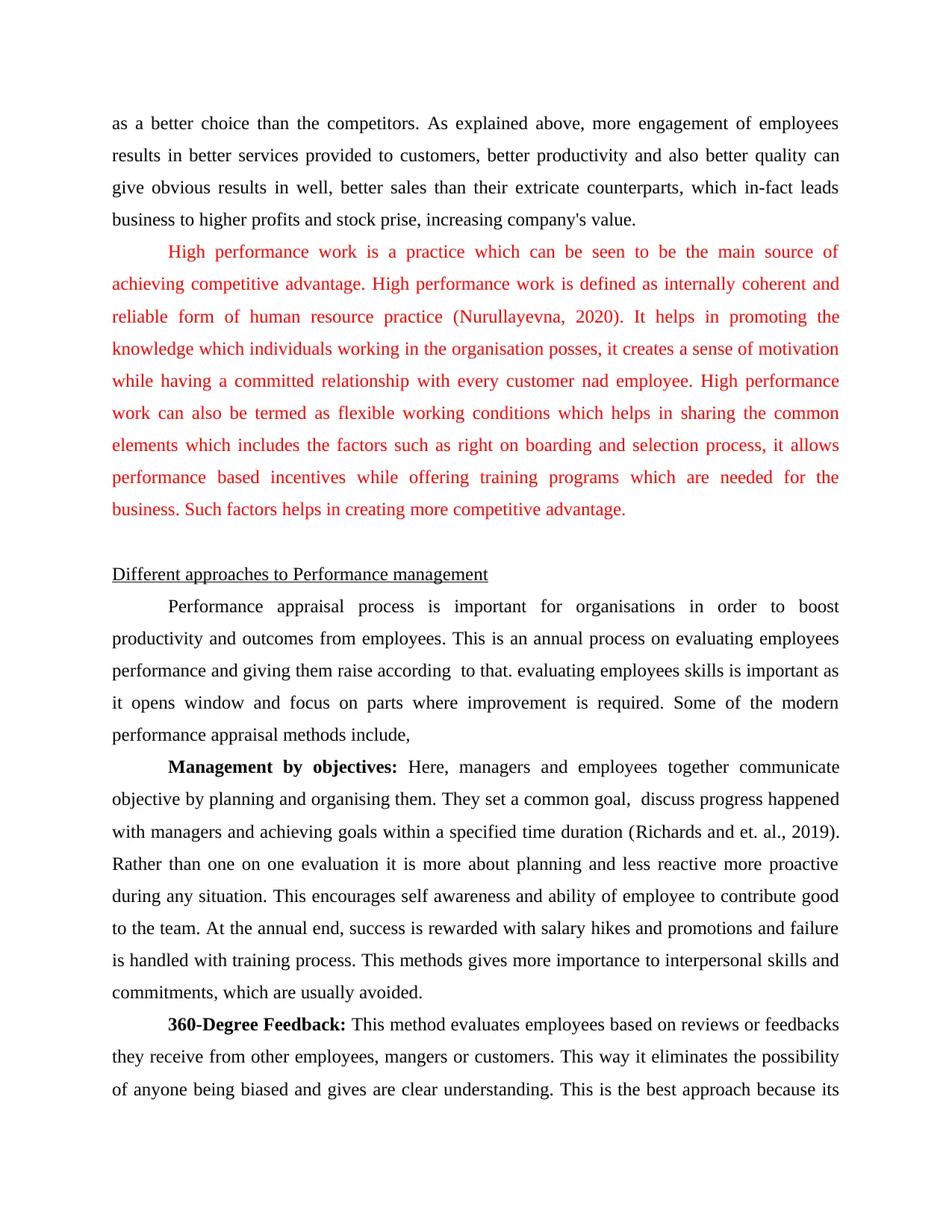
as a better choice than the competitors. As explained above, more engagement of employees
results in better services provided to customers, better productivity and also better quality can
give obvious results in well, better sales than their extricate counterparts, which in-fact leads
business to higher profits and stock prise, increasing company's value.
High performance work is a practice which can be seen to be the main source of
achieving competitive advantage. High performance work is defined as internally coherent and
reliable form of human resource practice (Nurullayevna, 2020). It helps in promoting the
knowledge which individuals working in the organisation posses, it creates a sense of motivation
while having a committed relationship with every customer nad employee. High performance
work can also be termed as flexible working conditions which helps in sharing the common
elements which includes the factors such as right on boarding and selection process, it allows
performance based incentives while offering training programs which are needed for the
business. Such factors helps in creating more competitive advantage.
Different approaches to Performance management
Performance appraisal process is important for organisations in order to boost
productivity and outcomes from employees. This is an annual process on evaluating employees
performance and giving them raise according to that. evaluating employees skills is important as
it opens window and focus on parts where improvement is required. Some of the modern
performance appraisal methods include,
Management by objectives: Here, managers and employees together communicate
objective by planning and organising them. They set a common goal, discuss progress happened
with managers and achieving goals within a specified time duration (Richards and et. al., 2019).
Rather than one on one evaluation it is more about planning and less reactive more proactive
during any situation. This encourages self awareness and ability of employee to contribute good
to the team. At the annual end, success is rewarded with salary hikes and promotions and failure
is handled with training process. This methods gives more importance to interpersonal skills and
commitments, which are usually avoided.
360-Degree Feedback: This method evaluates employees based on reviews or feedbacks
they receive from other employees, mangers or customers. This way it eliminates the possibility
of anyone being biased and gives are clear understanding. This is the best approach because its
results in better services provided to customers, better productivity and also better quality can
give obvious results in well, better sales than their extricate counterparts, which in-fact leads
business to higher profits and stock prise, increasing company's value.
High performance work is a practice which can be seen to be the main source of
achieving competitive advantage. High performance work is defined as internally coherent and
reliable form of human resource practice (Nurullayevna, 2020). It helps in promoting the
knowledge which individuals working in the organisation posses, it creates a sense of motivation
while having a committed relationship with every customer nad employee. High performance
work can also be termed as flexible working conditions which helps in sharing the common
elements which includes the factors such as right on boarding and selection process, it allows
performance based incentives while offering training programs which are needed for the
business. Such factors helps in creating more competitive advantage.
Different approaches to Performance management
Performance appraisal process is important for organisations in order to boost
productivity and outcomes from employees. This is an annual process on evaluating employees
performance and giving them raise according to that. evaluating employees skills is important as
it opens window and focus on parts where improvement is required. Some of the modern
performance appraisal methods include,
Management by objectives: Here, managers and employees together communicate
objective by planning and organising them. They set a common goal, discuss progress happened
with managers and achieving goals within a specified time duration (Richards and et. al., 2019).
Rather than one on one evaluation it is more about planning and less reactive more proactive
during any situation. This encourages self awareness and ability of employee to contribute good
to the team. At the annual end, success is rewarded with salary hikes and promotions and failure
is handled with training process. This methods gives more importance to interpersonal skills and
commitments, which are usually avoided.
360-Degree Feedback: This method evaluates employees based on reviews or feedbacks
they receive from other employees, mangers or customers. This way it eliminates the possibility
of anyone being biased and gives are clear understanding. This is the best approach because its

all encompassing and offers excellent view of employee. Self evaluation, helps them to look and
analyse at their own performance, understand their own strengths and weakness. Co-workers
develop unique perspective of its fellow colleague, making them most appropriate evaluator.
However, friendships or enmity towards someone may affect these results. Reportees have
different perspective from managers point of view, but the fear of retribution can affect the
results. Customers reviews are honest reviews and they can make the company know what they
want via their feedbacks. This method serves a key for initiation of activities such as coaching or
counselling. Performance feedback on work culture promotes engagements.
Behaviour related appraisals: This method brings out Qualitative as well as
quantitative benefits to the business. It is usually for employees who are supposed to work on
some detailed task and also take over on certain traits for example caring or patience and so on.
It is a fair way to asses employees performance (DeNisi and Murphy, 2017). Some advantages of
using is this method includes, accurate performance analysis, clear standards, elimination of
irrelevant variance in performance. Decreased chances of being bias.
Collaborative learning: It is process which works on the educational approach using the groups
and teams to motivate them learn together in the same work space. Different teams work together
and help in solving issues and problems of one another. Collaborative learning is process where
the different set of people come together to help in finishing the given task on time and
understanding the topics being presented in front of them (Greenwald, and et.al., 2017).
Collaborative learning helps in developing self management and leadership skills in the
employees while increasing the knowledge and soft skills of the employees. It helps in
improving the relations in between different departments and teams working within the
organisation along with improving the rention ate ad promoting the workplace engagement.
Effective learning: It is the process of exchanging the ideas and knowledge with a purpose and
intension of doing positive in the best possible way. It is representation of views and thoughts
coming from the sender which are supposed to understand by the receiver in the good context.
Effective communication helps in sending much clear message which is correct in all sense. The
intent of effective communication is to avoid any misleading and taking wrong decisions. The
communication form is very precise and reliable message. Some significance of effective
communication is it helps in the proper management of employees as it offer self discipline nad
open form of communication (Loes, C.N. and Pascarella, E.T., 2017). Effective communication
analyse at their own performance, understand their own strengths and weakness. Co-workers
develop unique perspective of its fellow colleague, making them most appropriate evaluator.
However, friendships or enmity towards someone may affect these results. Reportees have
different perspective from managers point of view, but the fear of retribution can affect the
results. Customers reviews are honest reviews and they can make the company know what they
want via their feedbacks. This method serves a key for initiation of activities such as coaching or
counselling. Performance feedback on work culture promotes engagements.
Behaviour related appraisals: This method brings out Qualitative as well as
quantitative benefits to the business. It is usually for employees who are supposed to work on
some detailed task and also take over on certain traits for example caring or patience and so on.
It is a fair way to asses employees performance (DeNisi and Murphy, 2017). Some advantages of
using is this method includes, accurate performance analysis, clear standards, elimination of
irrelevant variance in performance. Decreased chances of being bias.
Collaborative learning: It is process which works on the educational approach using the groups
and teams to motivate them learn together in the same work space. Different teams work together
and help in solving issues and problems of one another. Collaborative learning is process where
the different set of people come together to help in finishing the given task on time and
understanding the topics being presented in front of them (Greenwald, and et.al., 2017).
Collaborative learning helps in developing self management and leadership skills in the
employees while increasing the knowledge and soft skills of the employees. It helps in
improving the relations in between different departments and teams working within the
organisation along with improving the rention ate ad promoting the workplace engagement.
Effective learning: It is the process of exchanging the ideas and knowledge with a purpose and
intension of doing positive in the best possible way. It is representation of views and thoughts
coming from the sender which are supposed to understand by the receiver in the good context.
Effective communication helps in sending much clear message which is correct in all sense. The
intent of effective communication is to avoid any misleading and taking wrong decisions. The
communication form is very precise and reliable message. Some significance of effective
communication is it helps in the proper management of employees as it offer self discipline nad
open form of communication (Loes, C.N. and Pascarella, E.T., 2017). Effective communication
⊘ This is a preview!⊘
Do you want full access?
Subscribe today to unlock all pages.

Trusted by 1+ million students worldwide
1 out of 15
Related Documents
Your All-in-One AI-Powered Toolkit for Academic Success.
+13062052269
info@desklib.com
Available 24*7 on WhatsApp / Email
![[object Object]](/_next/static/media/star-bottom.7253800d.svg)
Unlock your academic potential
Copyright © 2020–2025 A2Z Services. All Rights Reserved. Developed and managed by ZUCOL.





